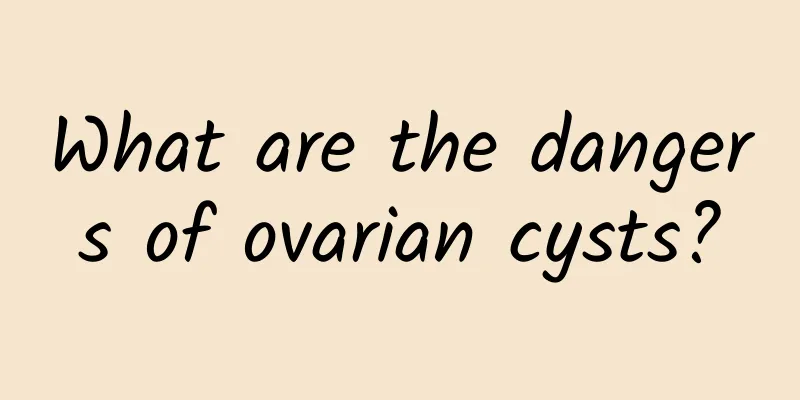Have you ever paid attention to the clinical manifestations of uterine fibroids?

|
Do you know what the clinical manifestations of uterine fibroids are? How should we judge the clinical manifestations of uterine fibroids? Next, let’s take a look at the clinical manifestations of uterine fibroids. The clinical manifestations of uterine fibroids can be divided into two aspects: signs and symptoms. 1. The physical signs of clinical manifestations of uterine fibroids are related to the location, size, number, position and degeneration of the fibroids. For larger fibroids, a hard, irregular, nodular mass can be palpated in the lower abdomen. During gynecological examination, the uterus with intramural fibroids is often irregularly enlarged and hard, with single or multiple nodular protrusions on the surface; subserosal fibroids can be palpated as hard spherical objects, connected to the uterus with a thin pedicle and movable; the uterus with submucosal fibroids is mostly uniformly enlarged. When the tumor is located at the cervical opening or prolapses from the vaginal opening, a red, smooth solid mass can be seen. If accompanied by infection, the surface can be covered with exudate or ulcerated, and the discharge has a foul odor. 2. The clinical manifestations of uterine fibroids are as follows: Most patients have no obvious symptoms, and they are occasionally found during gynecological examinations or B-ultrasound examinations. The symptoms and their severity are closely related to the location, size, growth rate, and degeneration of the fibroids. 1. Increased leucorrhea: Intramural fibroids increase the area of the uterine cavity, increase the secretion of endometrial glands, and are accompanied by pelvic congestion, resulting in increased leucorrhea; submucosal fibroids suspended in the vagina are susceptible to infection and necrosis on their surface, producing a large amount of purulent and bloody discharge and necrotic tissue discharge, accompanied by a foul odor. 2. Menstrual changes: They mostly occur in submucosal and intramural fibroids, manifested as menorrhagia, prolonged menstruation or irregular vaginal bleeding. 3. Lower abdominal mass: When the subserosal or intramural fibroids grow beyond the pelvic cavity, patients can usually feel the mass themselves and go to the hospital for treatment, which may be accompanied by a feeling of falling. 4. Impact on pregnancy and childbirth: Subserosal fibroids generally do not affect conception. If the intramural fibroids located in the uterine horns compress the interstitial part of the fallopian tube, and the submucosal fibroids cause endometrial infection, fibroids and endometrial hyperplasia, it may cause infertility. 5. Compression symptoms: Fibroids located in the lower part of the uterus and cervix, if embedded in the pelvic cavity, can compress pelvic tissues and nerves, causing lower abdominal pain and back pain. 6. Secondary anemia: Long-term menorrhagia leads to secondary anemia. In severe cases, symptoms include general fatigue, pale complexion, shortness of breath, palpitations, etc. 7. Pain: A relatively rare clinical manifestation of uterine fibroids. In addition to pain caused by compression of pelvic nerves, pedunculated submucosal fibroids can cause uterine contractions in the uterine cavity and cause pain; fibroids can block the cervical canal and hinder the outflow of menstrual blood, which can cause dysmenorrhea; pedunculated subserosal fibroids can cause pedicle torsion, or uterine fibroids that undergo red degeneration or infection during pregnancy can all cause severe abdominal pain. These are the main clinical manifestations of uterine fibroids. Although people say that the clinical manifestations of uterine fibroids are not very obvious, through the above analysis of the clinical manifestations of uterine fibroids, we believe that we can still see the clinical manifestations of uterine fibroids. If you have some of the above symptoms, please seek medical attention in time. Because these clinical manifestations of uterine fibroids can cause many diseases. If you want to know more about the clinical manifestations of uterine fibroids, please consult our online experts, who will answer your questions. Uterine fibroids http://www..com.cn/fuke/zgjl/ |
<<: Do you know how to treat uterine fibroids?
>>: Application of superconducting visual painless abortion technology
Recommend
Which hospital should I go to for treatment of threatened abortion?
Threatened miscarriage is becoming more and more ...
It turns out that eating vegetables first and then meat to lose weight is wrong! Famous weight loss doctor: Eating dietary fiber first can increase appetite
There are many diet instructions on the Internet ...
The Consumers' Foundation accepts the complaint after the refund of substandard milk powder was refused
In response to the recent seizure of 10 tons of e...
Common causes of vaginitis in women
Vaginitis, a gynecological disease, can seriously...
Women aged 20 to 50 should read this! Eat like this to stay healthy
Everyone hopes that they can live to old age in g...
What to do if uterine prolapse occurs
What should I do if I have uterine prolapse? Firs...
Is it better for women to take abortion pills or have an abortion? Women should consider these three points when choosing between medical abortion and surgical abortion.
In the case of an unexpected pregnancy, women wil...
Does hyperprolactinemia affect life expectancy?
Will hyperprolactinemia affect life expectancy? T...
How can women prevent dysmenorrhea?
In today's society, dysmenorrhea has become c...
Papaya = cancer prevention + detoxification, breast enhancement, "slimming"
Papaya, also known as the "king of beneficia...
The main causes of pelvic inflammatory disease in women
The incidence of pelvic inflammatory disease has ...
What are the dietary taboos for cervical warts
Competition in today's society is becoming in...
What are the symptoms of ovarian cysts?
Ovarian tumors are common tumors of the female re...
Can I stop taking medication for endometrial tuberculosis?
I started to have dysmenorrhea after getting marr...
What to eat during menopause - healthy recipes
Women in menopause will gradually experience a de...









